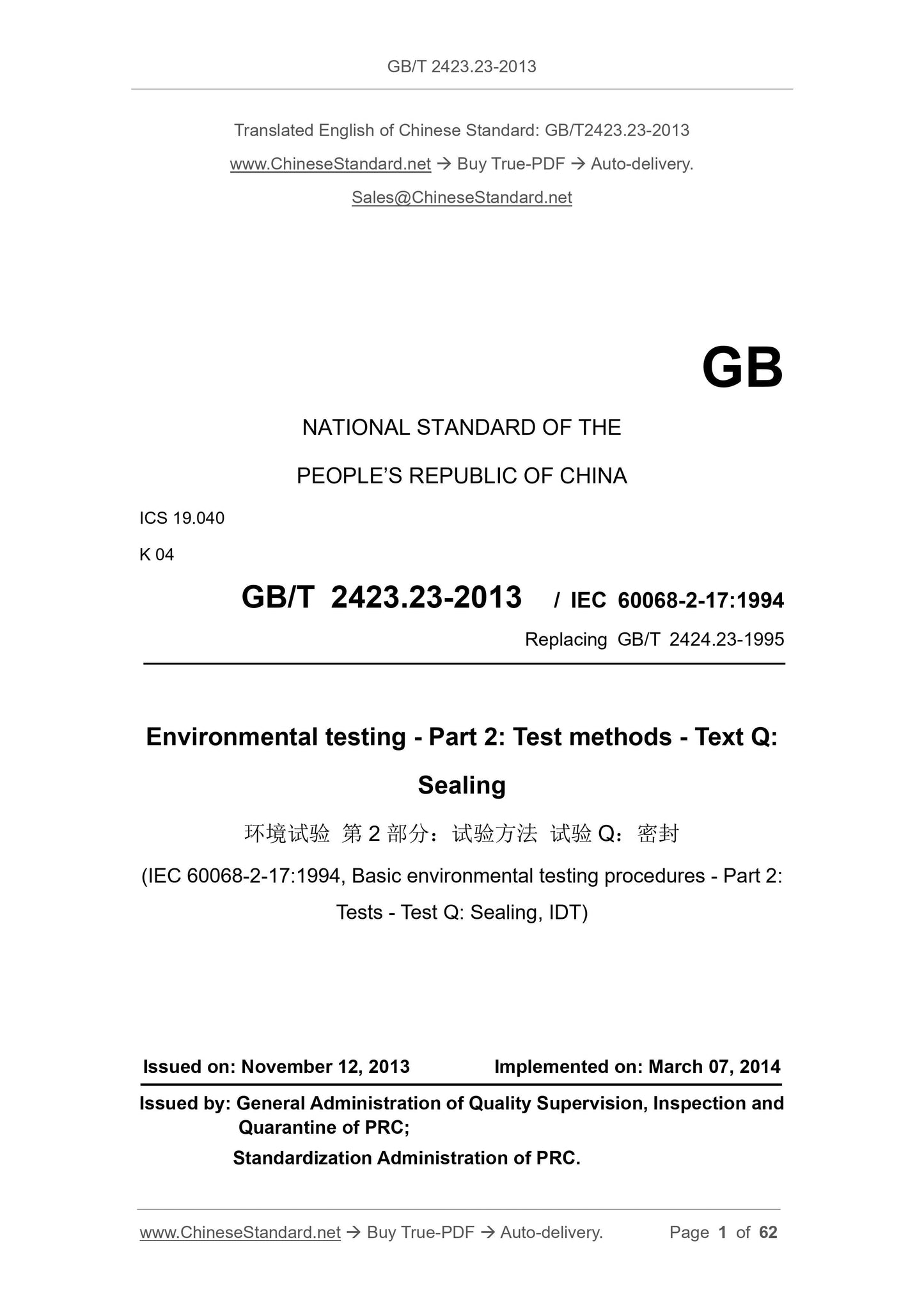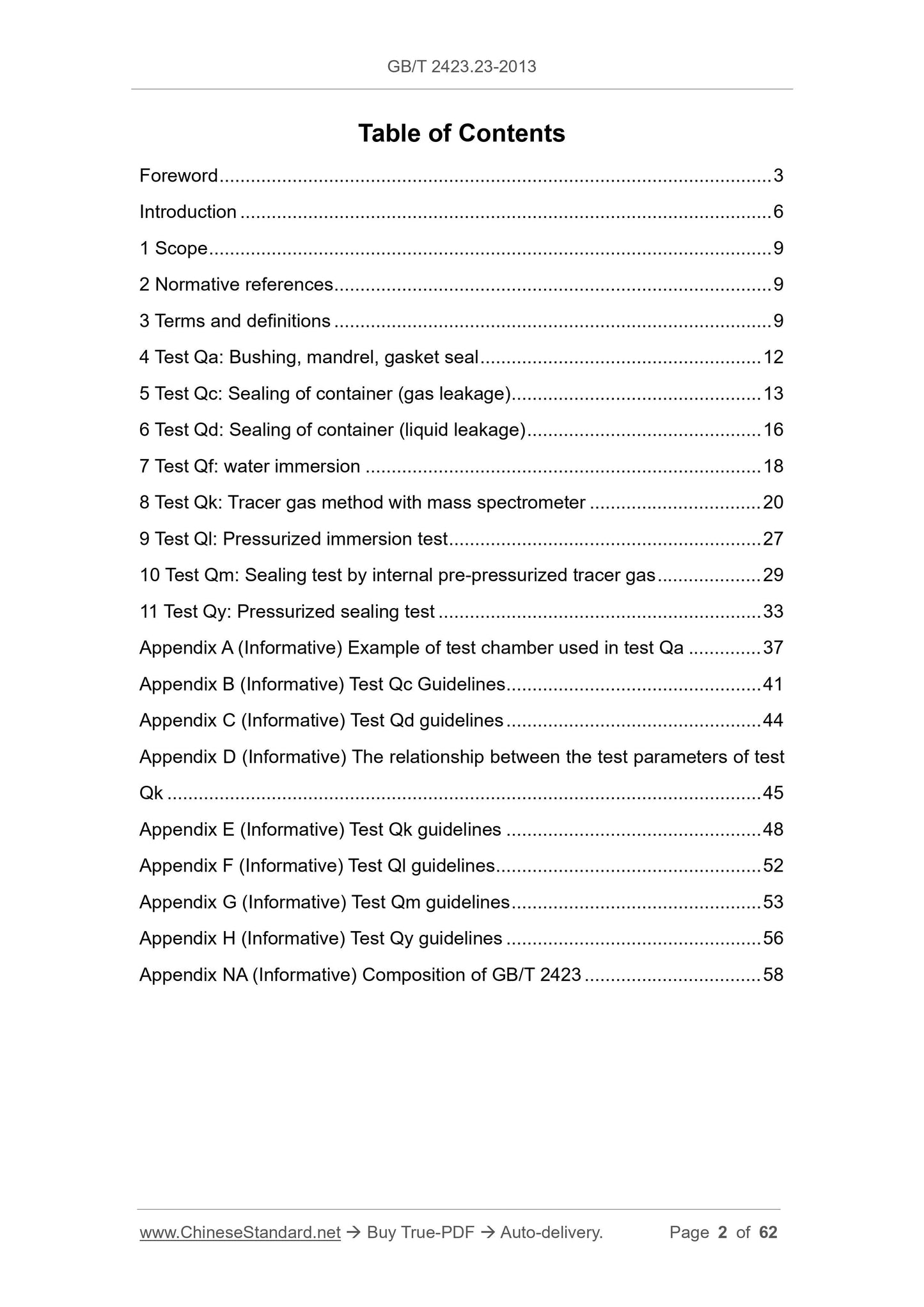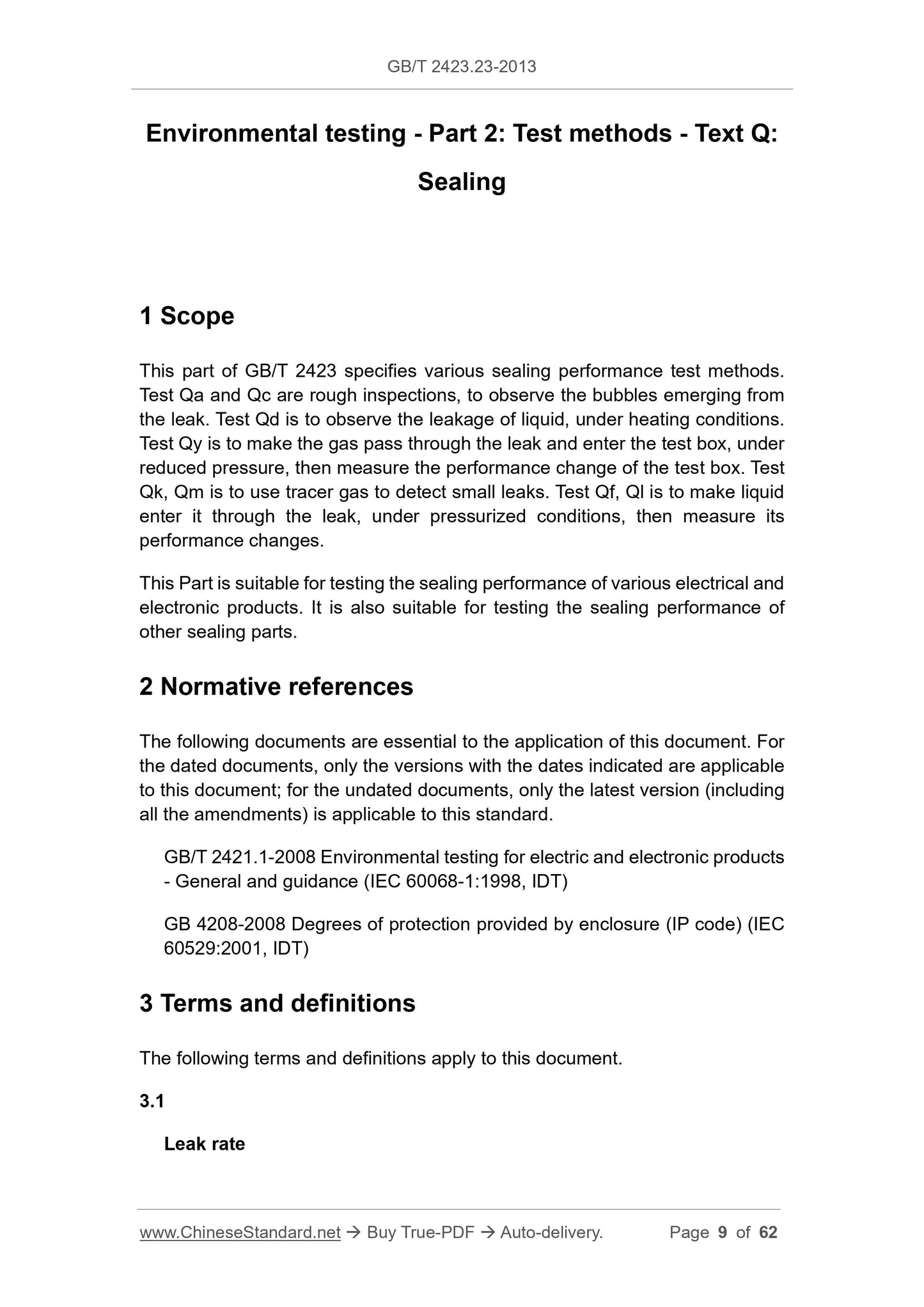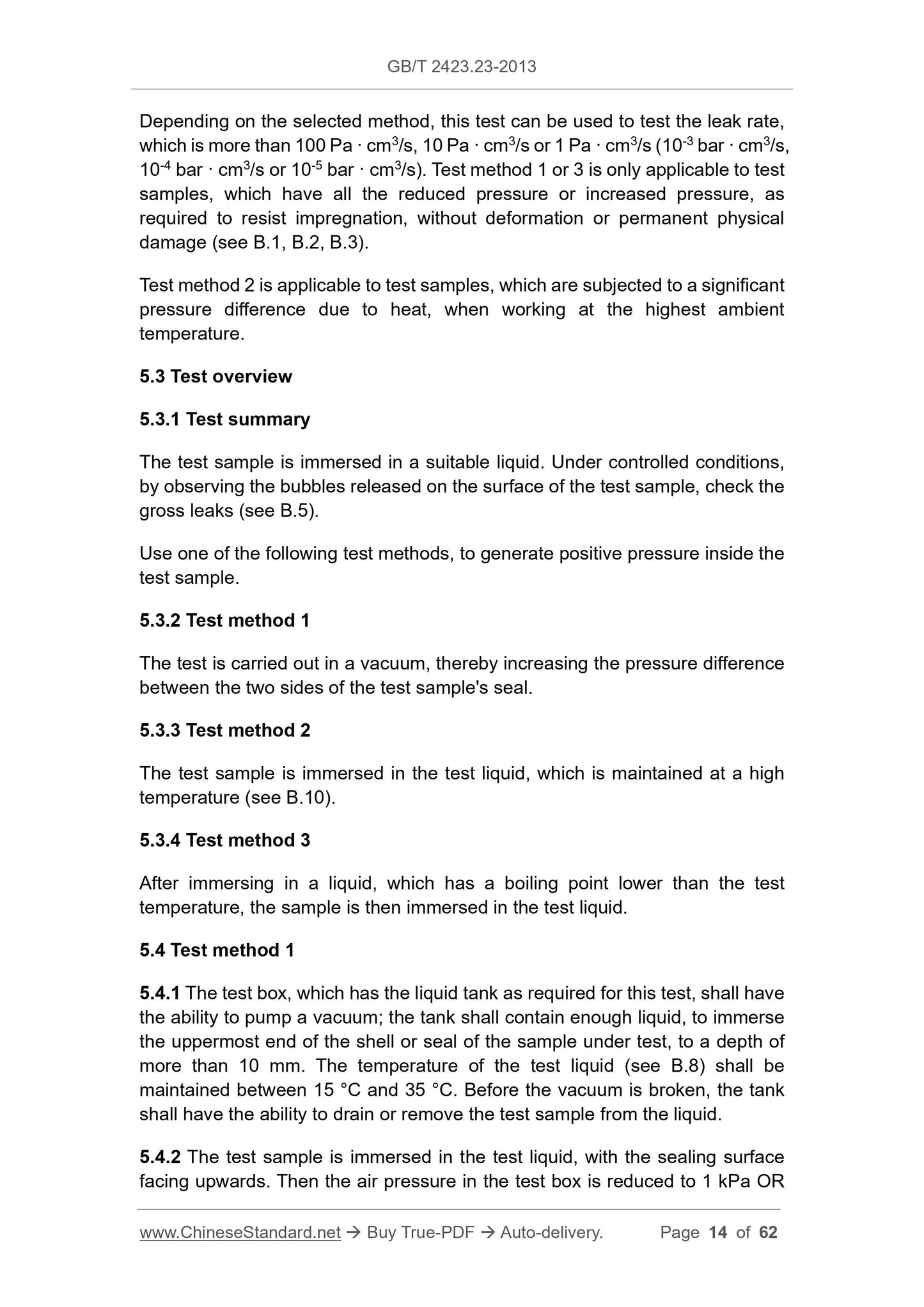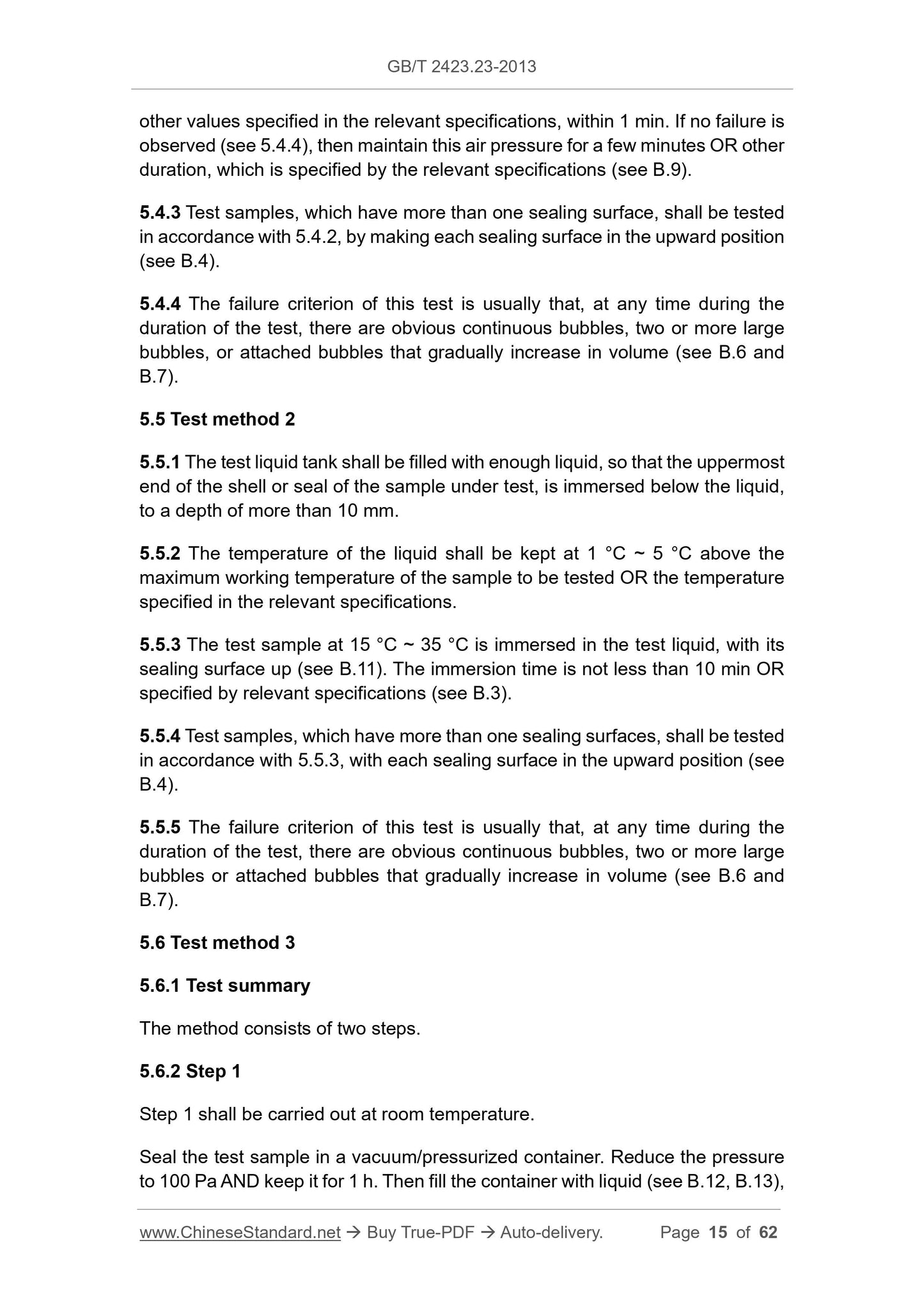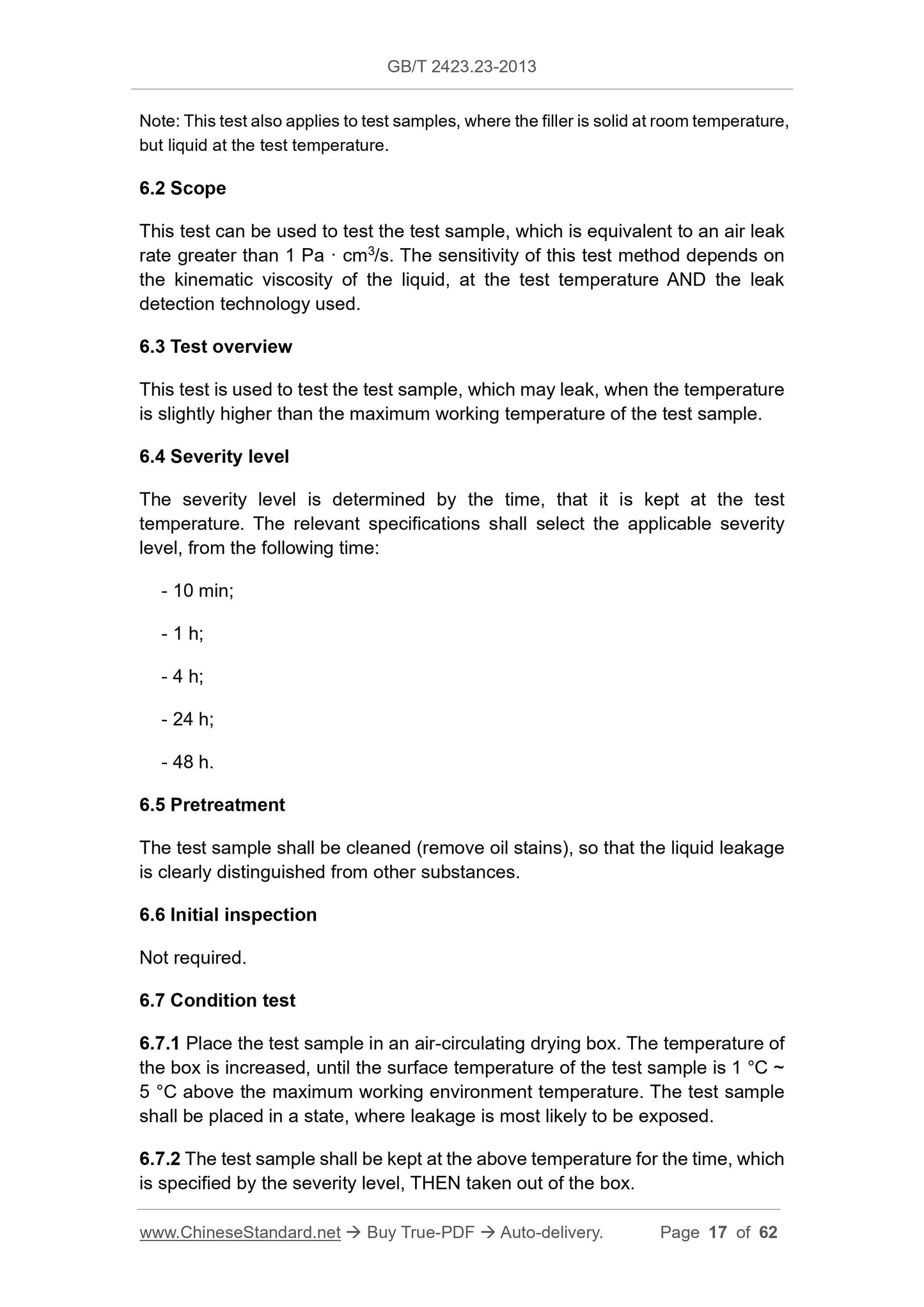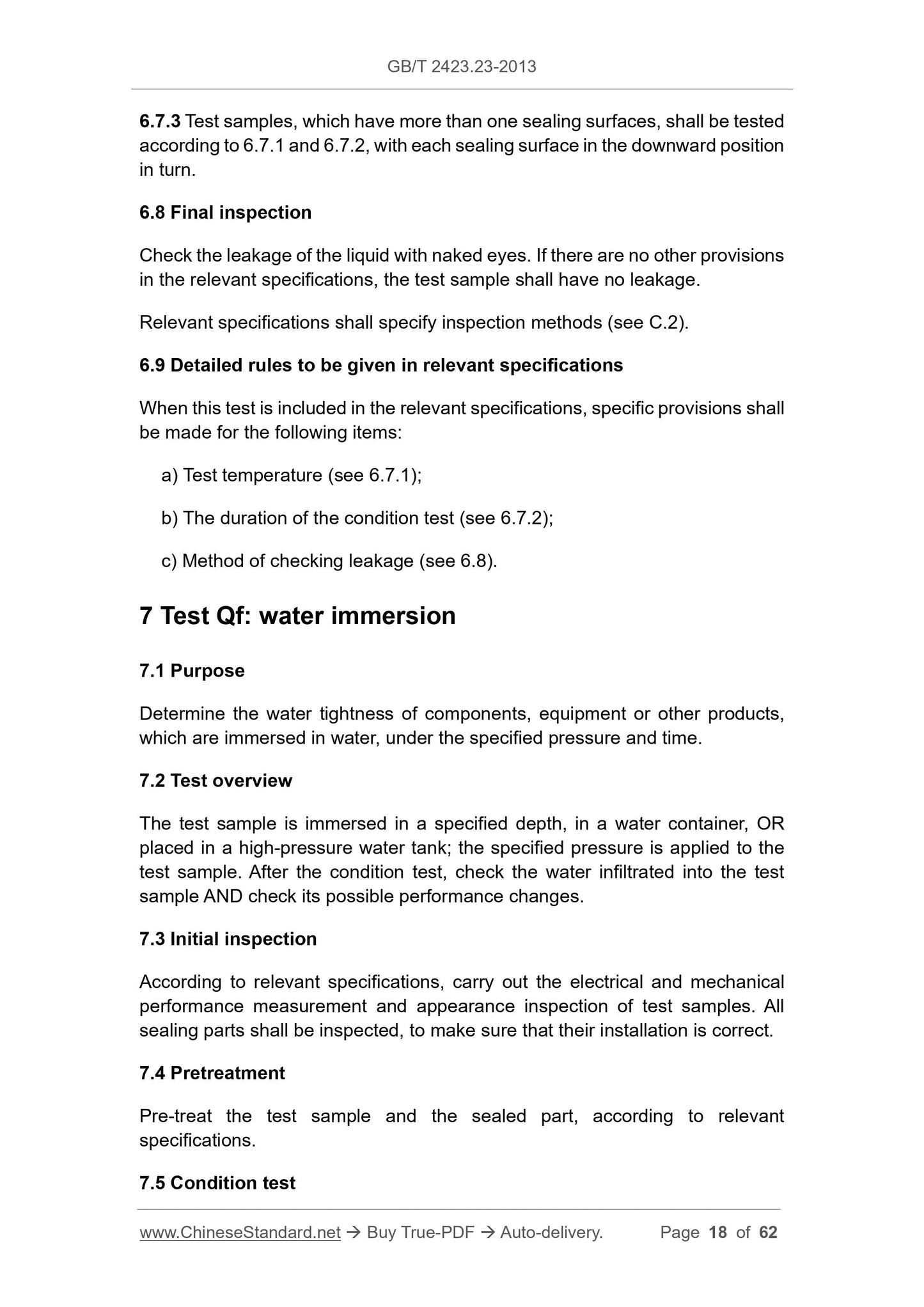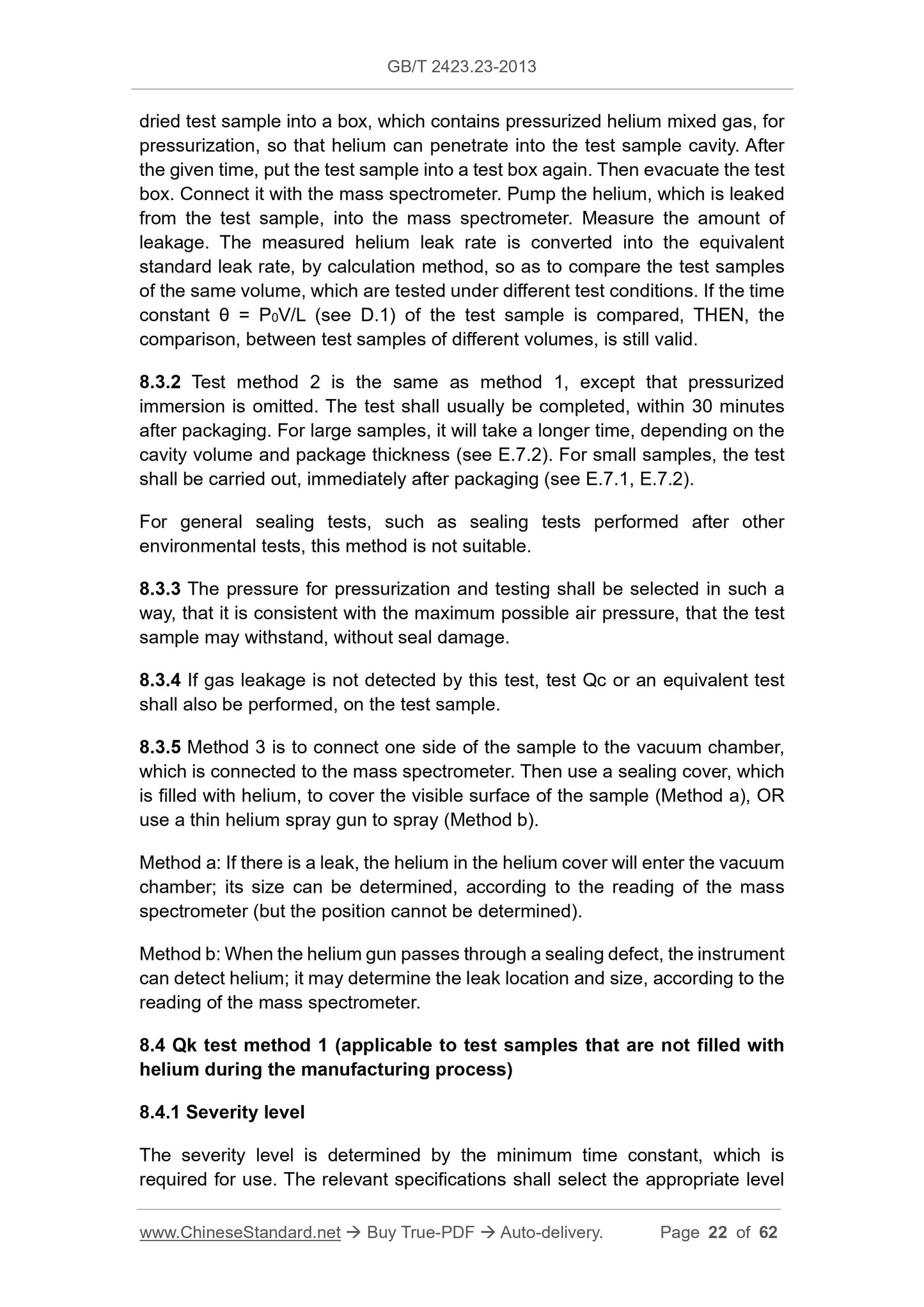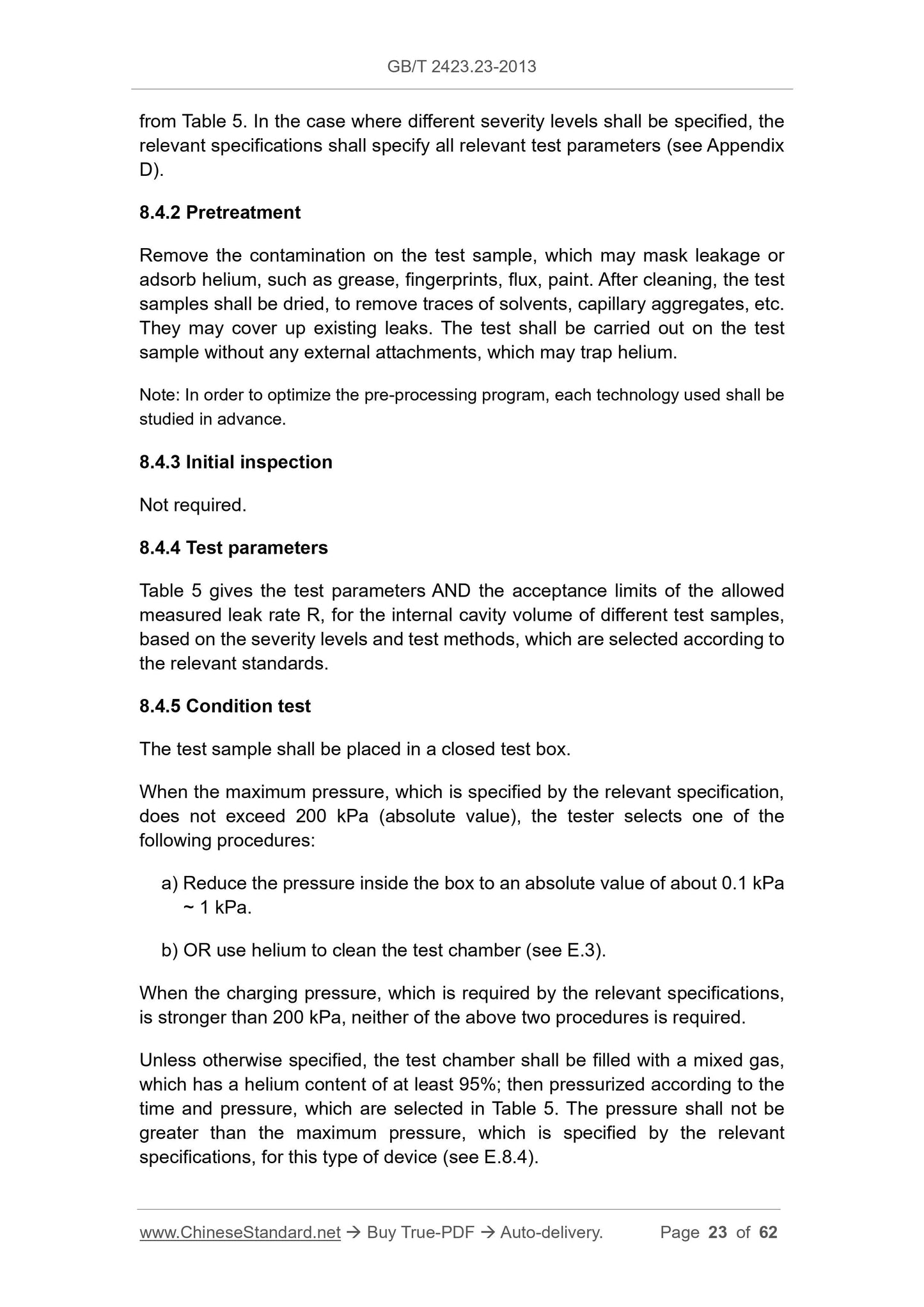1
/
of
12
www.ChineseStandard.us -- Field Test Asia Pte. Ltd.
GB/T 2423.23-2013 English PDF (GB/T2423.23-2013)
GB/T 2423.23-2013 English PDF (GB/T2423.23-2013)
Regular price
$590.00
Regular price
Sale price
$590.00
Unit price
/
per
Shipping calculated at checkout.
Couldn't load pickup availability
GB/T 2423.23-2013: Environmental testing - Part 2: Test methods - Test Q: Sealing
Delivery: 9 seconds. Download (& Email) true-PDF + Invoice.
Get Quotation: Click GB/T 2423.23-2013 (Self-service in 1-minute)
Historical versions (Master-website): GB/T 2423.23-2013
Preview True-PDF (Reload/Scroll-down if blank)
GB/T 2423.23-2013
GB
NATIONAL STANDARD OF THE
PEOPLE’S REPUBLIC OF CHINA
ICS 19.040
K 04
GB/T 2423.23-2013 / IEC 60068-2-17:1994
Replacing GB/T 2424.23-1995
Environmental testing - Part 2: Test methods - Text Q:
Sealing
(IEC 60068-2-17:1994, Basic environmental testing procedures - Part 2:
Tests - Test Q: Sealing, IDT)
ISSUED ON: NOVEMBER 12, 2013
IMPLEMENTED ON: MARCH 07, 2014
Issued by: General Administration of Quality Supervision, Inspection and
Quarantine of PRC;
Standardization Administration of PRC.
Table of Contents
Foreword ... 3
Introduction ... 6
1 Scope ... 9
2 Normative references ... 9
3 Terms and definitions ... 9
4 Test Qa: Bushing, mandrel, gasket seal ... 12
5 Test Qc: Sealing of container (gas leakage) ... 13
6 Test Qd: Sealing of container (liquid leakage) ... 16
7 Test Qf: water immersion ... 18
8 Test Qk: Tracer gas method with mass spectrometer ... 20
9 Test Ql: Pressurized immersion test ... 27
10 Test Qm: Sealing test by internal pre-pressurized tracer gas ... 29
11 Test Qy: Pressurized sealing test ... 33
Appendix A (Informative) Example of test chamber used in test Qa ... 37
Appendix B (Informative) Test Qc Guidelines ... 41
Appendix C (Informative) Test Qd guidelines ... 44
Appendix D (Informative) The relationship between the test parameters of test
Qk ... 45
Appendix E (Informative) Test Qk guidelines ... 48
Appendix F (Informative) Test Ql guidelines ... 52
Appendix G (Informative) Test Qm guidelines ... 53
Appendix H (Informative) Test Qy guidelines ... 56
Appendix NA (Informative) Composition of GB/T 2423 ... 58
Environmental testing - Part 2: Test methods - Text Q:
Sealing
1 Scope
This part of GB/T 2423 specifies various sealing performance test methods.
Test Qa and Qc are rough inspections, to observe the bubbles emerging from
the leak. Test Qd is to observe the leakage of liquid, under heating conditions.
Test Qy is to make the gas pass through the leak and enter the test box, under
reduced pressure, then measure the performance change of the test box. Test
Qk, Qm is to use tracer gas to detect small leaks. Test Qf, Ql is to make liquid
enter it through the leak, under pressurized conditions, then measure its
performance changes.
This Part is suitable for testing the sealing performance of various electrical and
electronic products. It is also suitable for testing the sealing performance of
other sealing parts.
2 Normative references
The following documents are essential to the application of this document. For
the dated documents, only the versions with the dates indicated are applicable
to this document; for the undated documents, only the latest version (including
all the amendments) is applicable to this standard.
GB/T 2421.1-2008 Environmental testing for electric and electronic products
- General and guidance (IEC 60068-1:1998, IDT)
GB 4208-2008 Degrees of protection provided by enclosure (IP code) (IEC
60529:2001, IDT)
3 Terms and definitions
The following terms and definitions apply to this document.
3.1
Leak rate
Depending on the selected method, this test can be used to test the leak rate,
which is more than 100 Pa · cm3/s, 10 Pa · cm3/s or 1 Pa · cm3/s (10-3 bar · cm3/s,
10-4 bar · cm3/s or 10-5 bar · cm3/s). Test method 1 or 3 is only applicable to test
samples, which have all the reduced pressure or increased pressure, as
required to resist impregnation, without deformation or permanent physical
damage (see B.1, B.2, B.3).
Test method 2 is applicable to test samples, which are subjected to a significant
pressure difference due to heat, when working at the highest ambient
temperature.
5.3 Test overview
5.3.1 Test summary
The test sample is immersed in a suitable liquid. Under controlled conditions,
by observing the bubbles released on the surface of the test sample, check the
gross leaks (see B.5).
Use one of the following test methods, to generate positive pressure inside the
test sample.
5.3.2 Test method 1
The test is carried out in a vacuum, thereby increasing the pressure difference
between the two sides of the test sample's seal.
5.3.3 Test method 2
The test sample is immersed in the test liquid, which is maintained at a high
temperature (see B.10).
5.3.4 Test method 3
After immersing in a liquid, which has a boiling point lower than the test
temperature, the sample is then immersed in the test liquid.
5.4 Test method 1
5.4.1 The test box, which has the liquid tank as required for this test, shall have
the ability to pump a vacuum; the tank shall contain enough liquid, to immerse
the uppermost end of the shell or seal of the sample under test, to a depth of
more than 10 mm. The temperature of the test liquid (see B.8) shall be
maintained between 15 °C and 35 °C. Before the vacuum is broken, the tank
shall have the ability to drain or remove the test sample from the liquid.
5.4.2 The test sample is immersed in the test liquid, with the sealing surface
facing upwards. Then the air pressure in the test box is reduced to 1 kPa OR
other values specified in the relevant specifications, within 1 min. If no failure is
observed (see 5.4.4), then maintain this air pressure for a few minutes OR other
duration, which is specified by the relevant specifications (see B.9).
5.4.3 Test samples, which have more than one sealing surface, shall be tested
in accordance with 5.4.2, by making each sealing surface in the upward position
(see B.4).
5.4.4 The failure criterion of this test is usually that, at any time during the
duration of the test, there are obvious continuous bubbles, two or more large
bubbles, or attached bubbles that gradually increase in volume (see B.6 and
B.7).
5.5 Test method 2
5.5.1 The test liquid tank shall be filled with enough liquid, so that the uppermost
end of the shell or seal of the sample under test, is immersed below the liquid,
to a depth of more than 10 mm.
5.5.2 The temperature of the liquid shall be kept at 1 °C ~ 5 °C above the
maximum working temperature of the sample to be tested OR the temperature
specified in the relevant specifications.
5.5.3 The test sample at 15 °C ~ 35 °C is immersed in the test liquid, with its
sealing surface up (see B.11). The immersion time is not less than 10 min OR
specified by relevant specifications (see B.3).
5.5.4 Test samples, which have more than one sealing surfaces, shall be tested
in accordance with 5.5.3, with each sealing surface in the upward position (see
B.4).
5.5.5 The failure criterion of this test is usually that, at any time during the
duration of the test, there are obvious continuous bubbles, two or more large
bubbles or attached bubbles that gradually increase in volume (see B.6 and
B.7).
5.6 Test method 3
5.6.1 Test summary
The method consists of two steps.
5.6.2 Step 1
Step 1 shall be carried out at room temperature.
Seal the test sample in a vacuum/pressurized container. Reduce the pressure
to 100 Pa AND keep it for 1 h. Then fill the container with liquid (see B.12, B.13),
Note: This test also applies to test samples, where the filler is solid at room temperature,
but liquid at the test temperature.
6.2 Scope
This test can be used to test the test sample, which is equivalent to an air leak
rate greater than 1 Pa · cm3/s. The sensitivity of this test method depends on
the kinematic viscosity of the liquid, at the test temperature AND the leak
detection technology used.
6.3 Test overview
This test is used to test the test sample, which may leak, when the temperature
is slightly higher than the maximum working temperature of the test sample.
6.4 Severity level
The severity level is determined by the time, that it is kept at the test
temperature. The relevant specifications shall select the applicable severity
level, from the following time:
- 10 min;
- 1 h;
- 4 h;
- 24 h;
- 48 h.
6.5 Pretreatment
The test sample shall be cleaned (remove oil stains), so that the liquid leakage
is clearly distinguished from other substances.
6.6 Initial inspection
Not required.
6.7 Condition test
6.7.1 Place the test sample in an air-circulating drying box. The temperature of
the box is increased, until the surface temperature of the test sample is 1 °C ~
5 °C above the maximum working environment temperature. The test sample
shall be placed in a state, where leakage is most likely to be exposed.
6.7.2 The test sample shall be kept at the above temperature for the time, which
is specified by the severity level, THEN taken out of the box.
6.7.3 Test samples, which have more than one sealing surfaces, shall be tested
according to 6.7.1 and 6.7.2, with each sealing surface in the downward position
in turn.
6.8 Final inspection
Check the leakage of the liquid with naked eyes. If there are no other provisions
in the relevant specifications, the test sample shall have no leakage.
Relevant specifications shall specify inspection methods (see C.2).
6.9 Detailed rules to be given in relevant specifications
When this test is included in the relevant specifications, specific provisions shall
be made for the following items:
a) Test temperature (see 6.7.1);
b) The duration of the condition test (see 6.7.2);
c) Method of checking leakage (see 6.8).
7 Test Qf: water immersion
7.1 Purpose
Determine the water tightness of components, equipment or other products,
which are immersed in water, under the specified pressure and time.
7.2 Test overview
The test sample is immersed in a specified depth, in a water container, OR
placed in a high-pressure water tank; the specified pressure is applied to the
test sample. After the condition test, check the water infiltrated into the test
sample AND check its possible performance changes.
7.3 Initial inspection
According to relevant specifications, carry out the electrical and mechanical
performance measurement and appearance inspection of test samples. All
sealing parts shall be inspected, to make sure that their installation is correct.
7.4 Pretreatment
Pre-treat the test sample and the sealed part, according to relevant
specifications.
7.5 Condition test
dried test sample into a box, which contains pressurized helium mixed gas, for
pressurization, so that helium can penetrate into the test sample cavity. After
the given time, put the test sample into a test box again. Then evacuate the test
box. Connect it with the mass spectrometer. Pump the helium, which is leaked
from the test sample, into the mass spectrometer. Measure the amount of
leakage. The measured helium leak rate is converted into the equivalent
standard leak rate, by calculation method, so as to compare the test samples
of the same volume, which are tested under different test conditions. If the time
constant θ = P0V/L (see D.1) of the test sample is compared, THEN, the
comparison, between test samples of different volumes, is still valid.
8.3.2 Test method 2 is the same as method 1, except that pressurized
immersion is omitted. The test shall usually be completed, within 30 minutes
after packaging. For large samples, it will take a longer time, depending on the
cavity volume and package thickness (see E.7.2). For small samples, the test
shall be carried out, immediately after packaging (see E.7.1, E.7.2).
For general sealing tests, such as sealing tests performed after other
environmental tests, this method is not suitable.
8.3.3 The pressure for pressurization and testing shall be selected in such a
way, that it is consistent with the maximum possible air pressure, that the test
sample may withstand, without seal damage.
8.3.4 If gas leakage is not detected by this test, test Qc or an equivalent test
shall also be performed, on the test sample.
8.3.5 Method 3 is to connect one side of the sample to the vacuum chamber,
which is connected to the mass spectrometer. Then use a sealing cover, which
is filled with helium, to cover the visible surface of the sample (Method a), OR
use a thin helium spray gun to spray (Method b).
Method a: If there is a leak, the helium in the helium cover will enter the vacuum
chamber; its size can be determined, according to the reading of the mass
spectrometer (but the position cannot be determined).
Method b: When the helium gun passes through a sealing defect, the instrument
can detect helium; it may determine the leak location and size, according to the
reading of the mass spectrometer.
8.4 Qk test method 1 (applicable to test samples that are not filled with
helium during the manufacturing process)
8.4.1 Severity level
The severity level is determined by the minimum time constant, which is
required for use. The relevant specifications shall select the appropriate level
from Table 5. In the case where different severity levels shall be specified, the
relevant specifications shall specify all relevant test parameters (see Appendix
D).
8.4.2 Pretreatment
Remove the contamination on the test sample, which may mask leakage or
adsorb helium, such as grease, fingerprints, flux, paint. After cleaning, the test
samples shall be dried, to remove traces of solvents, capillary aggregates, etc.
They may cover up existing leaks. The test shall be carried out on the test
sample without any external attachments, which may trap helium.
Note: In order to optimize the pre-processing program, each technology used shall be
studied in advance.
8.4.3 Initial inspection
Not required.
8.4.4 Test parameters
Table 5 gives the test parameters AND the acceptance limits of the allowed
measured leak rate R, for the internal cavity volume of different test samples,
based on the severity levels and test methods, which are selected according to
the relevant standards.
8.4.5 Condition test
The test sample shall be placed in a closed test box.
When the maximum pressure, which is specified by the relevant specification,
does not exceed 200 kPa (absol...
Delivery: 9 seconds. Download (& Email) true-PDF + Invoice.
Get Quotation: Click GB/T 2423.23-2013 (Self-service in 1-minute)
Historical versions (Master-website): GB/T 2423.23-2013
Preview True-PDF (Reload/Scroll-down if blank)
GB/T 2423.23-2013
GB
NATIONAL STANDARD OF THE
PEOPLE’S REPUBLIC OF CHINA
ICS 19.040
K 04
GB/T 2423.23-2013 / IEC 60068-2-17:1994
Replacing GB/T 2424.23-1995
Environmental testing - Part 2: Test methods - Text Q:
Sealing
(IEC 60068-2-17:1994, Basic environmental testing procedures - Part 2:
Tests - Test Q: Sealing, IDT)
ISSUED ON: NOVEMBER 12, 2013
IMPLEMENTED ON: MARCH 07, 2014
Issued by: General Administration of Quality Supervision, Inspection and
Quarantine of PRC;
Standardization Administration of PRC.
Table of Contents
Foreword ... 3
Introduction ... 6
1 Scope ... 9
2 Normative references ... 9
3 Terms and definitions ... 9
4 Test Qa: Bushing, mandrel, gasket seal ... 12
5 Test Qc: Sealing of container (gas leakage) ... 13
6 Test Qd: Sealing of container (liquid leakage) ... 16
7 Test Qf: water immersion ... 18
8 Test Qk: Tracer gas method with mass spectrometer ... 20
9 Test Ql: Pressurized immersion test ... 27
10 Test Qm: Sealing test by internal pre-pressurized tracer gas ... 29
11 Test Qy: Pressurized sealing test ... 33
Appendix A (Informative) Example of test chamber used in test Qa ... 37
Appendix B (Informative) Test Qc Guidelines ... 41
Appendix C (Informative) Test Qd guidelines ... 44
Appendix D (Informative) The relationship between the test parameters of test
Qk ... 45
Appendix E (Informative) Test Qk guidelines ... 48
Appendix F (Informative) Test Ql guidelines ... 52
Appendix G (Informative) Test Qm guidelines ... 53
Appendix H (Informative) Test Qy guidelines ... 56
Appendix NA (Informative) Composition of GB/T 2423 ... 58
Environmental testing - Part 2: Test methods - Text Q:
Sealing
1 Scope
This part of GB/T 2423 specifies various sealing performance test methods.
Test Qa and Qc are rough inspections, to observe the bubbles emerging from
the leak. Test Qd is to observe the leakage of liquid, under heating conditions.
Test Qy is to make the gas pass through the leak and enter the test box, under
reduced pressure, then measure the performance change of the test box. Test
Qk, Qm is to use tracer gas to detect small leaks. Test Qf, Ql is to make liquid
enter it through the leak, under pressurized conditions, then measure its
performance changes.
This Part is suitable for testing the sealing performance of various electrical and
electronic products. It is also suitable for testing the sealing performance of
other sealing parts.
2 Normative references
The following documents are essential to the application of this document. For
the dated documents, only the versions with the dates indicated are applicable
to this document; for the undated documents, only the latest version (including
all the amendments) is applicable to this standard.
GB/T 2421.1-2008 Environmental testing for electric and electronic products
- General and guidance (IEC 60068-1:1998, IDT)
GB 4208-2008 Degrees of protection provided by enclosure (IP code) (IEC
60529:2001, IDT)
3 Terms and definitions
The following terms and definitions apply to this document.
3.1
Leak rate
Depending on the selected method, this test can be used to test the leak rate,
which is more than 100 Pa · cm3/s, 10 Pa · cm3/s or 1 Pa · cm3/s (10-3 bar · cm3/s,
10-4 bar · cm3/s or 10-5 bar · cm3/s). Test method 1 or 3 is only applicable to test
samples, which have all the reduced pressure or increased pressure, as
required to resist impregnation, without deformation or permanent physical
damage (see B.1, B.2, B.3).
Test method 2 is applicable to test samples, which are subjected to a significant
pressure difference due to heat, when working at the highest ambient
temperature.
5.3 Test overview
5.3.1 Test summary
The test sample is immersed in a suitable liquid. Under controlled conditions,
by observing the bubbles released on the surface of the test sample, check the
gross leaks (see B.5).
Use one of the following test methods, to generate positive pressure inside the
test sample.
5.3.2 Test method 1
The test is carried out in a vacuum, thereby increasing the pressure difference
between the two sides of the test sample's seal.
5.3.3 Test method 2
The test sample is immersed in the test liquid, which is maintained at a high
temperature (see B.10).
5.3.4 Test method 3
After immersing in a liquid, which has a boiling point lower than the test
temperature, the sample is then immersed in the test liquid.
5.4 Test method 1
5.4.1 The test box, which has the liquid tank as required for this test, shall have
the ability to pump a vacuum; the tank shall contain enough liquid, to immerse
the uppermost end of the shell or seal of the sample under test, to a depth of
more than 10 mm. The temperature of the test liquid (see B.8) shall be
maintained between 15 °C and 35 °C. Before the vacuum is broken, the tank
shall have the ability to drain or remove the test sample from the liquid.
5.4.2 The test sample is immersed in the test liquid, with the sealing surface
facing upwards. Then the air pressure in the test box is reduced to 1 kPa OR
other values specified in the relevant specifications, within 1 min. If no failure is
observed (see 5.4.4), then maintain this air pressure for a few minutes OR other
duration, which is specified by the relevant specifications (see B.9).
5.4.3 Test samples, which have more than one sealing surface, shall be tested
in accordance with 5.4.2, by making each sealing surface in the upward position
(see B.4).
5.4.4 The failure criterion of this test is usually that, at any time during the
duration of the test, there are obvious continuous bubbles, two or more large
bubbles, or attached bubbles that gradually increase in volume (see B.6 and
B.7).
5.5 Test method 2
5.5.1 The test liquid tank shall be filled with enough liquid, so that the uppermost
end of the shell or seal of the sample under test, is immersed below the liquid,
to a depth of more than 10 mm.
5.5.2 The temperature of the liquid shall be kept at 1 °C ~ 5 °C above the
maximum working temperature of the sample to be tested OR the temperature
specified in the relevant specifications.
5.5.3 The test sample at 15 °C ~ 35 °C is immersed in the test liquid, with its
sealing surface up (see B.11). The immersion time is not less than 10 min OR
specified by relevant specifications (see B.3).
5.5.4 Test samples, which have more than one sealing surfaces, shall be tested
in accordance with 5.5.3, with each sealing surface in the upward position (see
B.4).
5.5.5 The failure criterion of this test is usually that, at any time during the
duration of the test, there are obvious continuous bubbles, two or more large
bubbles or attached bubbles that gradually increase in volume (see B.6 and
B.7).
5.6 Test method 3
5.6.1 Test summary
The method consists of two steps.
5.6.2 Step 1
Step 1 shall be carried out at room temperature.
Seal the test sample in a vacuum/pressurized container. Reduce the pressure
to 100 Pa AND keep it for 1 h. Then fill the container with liquid (see B.12, B.13),
Note: This test also applies to test samples, where the filler is solid at room temperature,
but liquid at the test temperature.
6.2 Scope
This test can be used to test the test sample, which is equivalent to an air leak
rate greater than 1 Pa · cm3/s. The sensitivity of this test method depends on
the kinematic viscosity of the liquid, at the test temperature AND the leak
detection technology used.
6.3 Test overview
This test is used to test the test sample, which may leak, when the temperature
is slightly higher than the maximum working temperature of the test sample.
6.4 Severity level
The severity level is determined by the time, that it is kept at the test
temperature. The relevant specifications shall select the applicable severity
level, from the following time:
- 10 min;
- 1 h;
- 4 h;
- 24 h;
- 48 h.
6.5 Pretreatment
The test sample shall be cleaned (remove oil stains), so that the liquid leakage
is clearly distinguished from other substances.
6.6 Initial inspection
Not required.
6.7 Condition test
6.7.1 Place the test sample in an air-circulating drying box. The temperature of
the box is increased, until the surface temperature of the test sample is 1 °C ~
5 °C above the maximum working environment temperature. The test sample
shall be placed in a state, where leakage is most likely to be exposed.
6.7.2 The test sample shall be kept at the above temperature for the time, which
is specified by the severity level, THEN taken out of the box.
6.7.3 Test samples, which have more than one sealing surfaces, shall be tested
according to 6.7.1 and 6.7.2, with each sealing surface in the downward position
in turn.
6.8 Final inspection
Check the leakage of the liquid with naked eyes. If there are no other provisions
in the relevant specifications, the test sample shall have no leakage.
Relevant specifications shall specify inspection methods (see C.2).
6.9 Detailed rules to be given in relevant specifications
When this test is included in the relevant specifications, specific provisions shall
be made for the following items:
a) Test temperature (see 6.7.1);
b) The duration of the condition test (see 6.7.2);
c) Method of checking leakage (see 6.8).
7 Test Qf: water immersion
7.1 Purpose
Determine the water tightness of components, equipment or other products,
which are immersed in water, under the specified pressure and time.
7.2 Test overview
The test sample is immersed in a specified depth, in a water container, OR
placed in a high-pressure water tank; the specified pressure is applied to the
test sample. After the condition test, check the water infiltrated into the test
sample AND check its possible performance changes.
7.3 Initial inspection
According to relevant specifications, carry out the electrical and mechanical
performance measurement and appearance inspection of test samples. All
sealing parts shall be inspected, to make sure that their installation is correct.
7.4 Pretreatment
Pre-treat the test sample and the sealed part, according to relevant
specifications.
7.5 Condition test
dried test sample into a box, which contains pressurized helium mixed gas, for
pressurization, so that helium can penetrate into the test sample cavity. After
the given time, put the test sample into a test box again. Then evacuate the test
box. Connect it with the mass spectrometer. Pump the helium, which is leaked
from the test sample, into the mass spectrometer. Measure the amount of
leakage. The measured helium leak rate is converted into the equivalent
standard leak rate, by calculation method, so as to compare the test samples
of the same volume, which are tested under different test conditions. If the time
constant θ = P0V/L (see D.1) of the test sample is compared, THEN, the
comparison, between test samples of different volumes, is still valid.
8.3.2 Test method 2 is the same as method 1, except that pressurized
immersion is omitted. The test shall usually be completed, within 30 minutes
after packaging. For large samples, it will take a longer time, depending on the
cavity volume and package thickness (see E.7.2). For small samples, the test
shall be carried out, immediately after packaging (see E.7.1, E.7.2).
For general sealing tests, such as sealing tests performed after other
environmental tests, this method is not suitable.
8.3.3 The pressure for pressurization and testing shall be selected in such a
way, that it is consistent with the maximum possible air pressure, that the test
sample may withstand, without seal damage.
8.3.4 If gas leakage is not detected by this test, test Qc or an equivalent test
shall also be performed, on the test sample.
8.3.5 Method 3 is to connect one side of the sample to the vacuum chamber,
which is connected to the mass spectrometer. Then use a sealing cover, which
is filled with helium, to cover the visible surface of the sample (Method a), OR
use a thin helium spray gun to spray (Method b).
Method a: If there is a leak, the helium in the helium cover will enter the vacuum
chamber; its size can be determined, according to the reading of the mass
spectrometer (but the position cannot be determined).
Method b: When the helium gun passes through a sealing defect, the instrument
can detect helium; it may determine the leak location and size, according to the
reading of the mass spectrometer.
8.4 Qk test method 1 (applicable to test samples that are not filled with
helium during the manufacturing process)
8.4.1 Severity level
The severity level is determined by the minimum time constant, which is
required for use. The relevant specifications shall select the appropriate level
from Table 5. In the case where different severity levels shall be specified, the
relevant specifications shall specify all relevant test parameters (see Appendix
D).
8.4.2 Pretreatment
Remove the contamination on the test sample, which may mask leakage or
adsorb helium, such as grease, fingerprints, flux, paint. After cleaning, the test
samples shall be dried, to remove traces of solvents, capillary aggregates, etc.
They may cover up existing leaks. The test shall be carried out on the test
sample without any external attachments, which may trap helium.
Note: In order to optimize the pre-processing program, each technology used shall be
studied in advance.
8.4.3 Initial inspection
Not required.
8.4.4 Test parameters
Table 5 gives the test parameters AND the acceptance limits of the allowed
measured leak rate R, for the internal cavity volume of different test samples,
based on the severity levels and test methods, which are selected according to
the relevant standards.
8.4.5 Condition test
The test sample shall be placed in a closed test box.
When the maximum pressure, which is specified by the relevant specification,
does not exceed 200 kPa (absol...
Share
